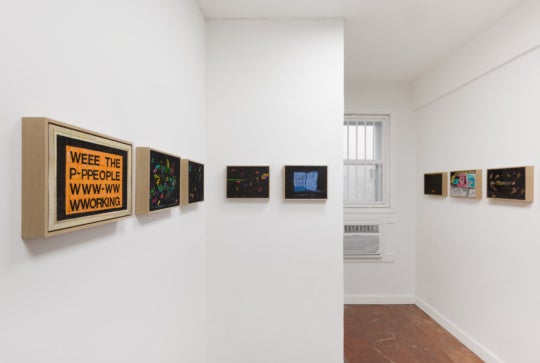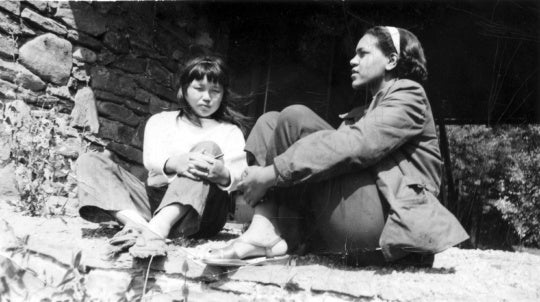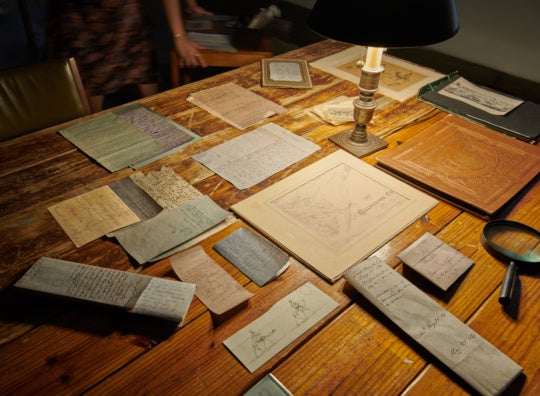
Sarah Emerson created her latest mural, Black Sea of Trees, specifically for the Project Atrium at the Museum of Contemporary Art (MOCA) in Jacksonville. At approximately 2660 square feet, it is the latest and largest addition to her Underland series [March 23-July 7, 2013]. Also on view at MOCA is Emerson’s preliminary drawing for the mural project and select smaller works on canvas. Concurrently, she is showing a collection of paintings and drawings in a solo exhibition titled Dog Days at Space Eight Gallery in St. Augustine,[June 7-July 31, 2013].
At MOCA, Emerson’s mural climbs upward and spills down the walls of the sunlit atrium, visible from four different floors within the museum. Her flatly painted layers of ambiguous space bubble over each other, gape open wide, and grow threatening vegetation. Amidst these layers, the smirks and sneers of hollow skulls are the postmortem signifiers of humanity’s poisonous deeds. Tumbling down from above, an illustrious, Wild West-like, dimensional text spells out “SAFE & SOUND.” This punchy jest reads as either reverse psychology or a children’s fable adding to the instability of the muck and mire.
Black Sea of Trees creates a strong, bodily reaction—in part due to scale—not present in her paintings. Details and accents draw the viewer close, but then, too close; the haunting scene is overwhelming. Slow, metered steps backward set the viewer at a safe distance. From there the mural feels cold, flat, and graphic. Up close, however, slight inconsistencies give away the artist’s mark. Actual paint dribbles and flecks are tiny and real and become more comforting than the incorporated text; indicating that the large, swelling, viscous “sea” is in truth a fabricated environment. In Emerson’s paintings the populous, but sometimes well-camouflaged, skulls are more proportional to a human’s head making them feel concrete. However, in the mural, her repetitive imagery is at an exaggerated scale, dwarfing the viewer amongst the swarming landscape and its inhabitants, making the scene more symbolic or figurative.
In Mel Bochner’s statement “Walls” [in Murs, Paris: Centre Georges Pompidou, 1981], he discusses the difference between a painting on canvas, with a pre-determined size and relationship, to that of “a painting done directly on the wall [where] the architecture becomes the boundary, confining the limit…Therefore, space rather than surface is the support.” Emerson’s mural negotiates the interactions of her invented landscape with the surrounding walls and architectural features that rise centrally through the museum. And, her mural is the collision of two very different spaces: the clean, cool museum interior, and her abstracted, churning and fantastical land. In this context, Black Sea of Trees reads more like a painted theater set, a stand in for something potentially more threatening. The created space of the mural does however require the viewer to layer their perception: Its scale alone prevents the entire image from being viewed directly or all at once.
In interviews concerning her process and imagery development, Sarah Emerson recalls stories of her nomadic upbringing (as an explorer amidst the suburban sprawl); draws from the human terrors that are preserved in battlegrounds; discusses how raising her own children forces her to answer why people act the way they do; and tells how the haunting rapture of the Japanese Aokigahara Forest (a legendary forest for suicides) has provided dark content for exploration in her Underland series. In Aokigahara, the forest consumes people who venture there. The dense network of branches prevents the reassurance of sunlight creating a lapse in time, and magnetic rocks make navigation a lost cause. Even brightly colored ribbons that are left by search parties become ominous indicators of the lost and not found.

Despite being complex and densely layered, overall, her landscape paintings lack compelling difference and become repetitive. The paintings in both Space Eight and MOCA display only minor shifts in style, content, and narrative. Color palette, as well, remains relatively consistent—other than some welcome neon threads of oranges and hot pinks. Although this unifies an ongoing investigation of an imagined realm, contributing to the feeling of being lost—as if in a house of mirrors—it lacks an affective or desperate punctuation.
However, the smaller gouache drawings present a greater variety of quite different elevations and terrain, though still keeping an ambiguous perspective. Some are even articulated by mouth-like grinning caves that are set hard and black against more muted surroundings. Of the fifteen works, only two works in Space Eight present an alteration to the repeating skulls entwined in thick plantlike forms with no clear up, down, or out: The painting Bright Moon Ghost reveals a deer entranced, fracturing into the weave of the surroundings, and the gouache Thought and Memory silhouettes two birds positioned similar to the cave-like openings featured throughout Emerson’s works. Only the shimmer of sprinkled rhinestones offer a spark of light in these darkened purgatories.

Arguable associations could tie Emerson’s work to street art, counterculture, tattoos, and even drug-induced hallucinations. The patterns and flatness could compliment contemporary interior design treatments similar to wall decals. Even relationships as vast as memento mori still lives, American regionalists, and super flat Takashi Murakami works, indicate the expansive field of style and content Emerson mines. The mural, which took approximately one week to complete, could be a cautionary tale—magnifying what has already come to pass, and warning for what lies ahead as her paintings present a new chapter. It’s almost as if the lavish, mischievous and hybrid creatures of Hieronymus Bosch’s The Garden of Earthly Delights (ca. 1500-1505) have slinked off, seeking refuge in distant provinces and leaving nature to reclaim its territory fighting against the polluted remains in the tales of Sarah Emerson’s Underland.




